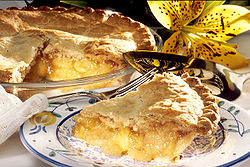Pie
A pie is a baked dish which is usually made of a pastry dough casing that covers or completely contains a filling of various sweet or savoury ingredients. Pies are defined by their crusts. A filled pie (also single-crust or bottom-crust), has pastry lining the baking dish, and the filling is placed on top of the pastry, but left open. A top-crust pie, which may also be called a cobbler, has the filling in the bottom of the dish and the filling covered with a pastry or other covering before baking. A two-crust pie has the filling completely enclosed in the pastry shell. Flaky pastry is a typical kind of pastry used for pie crusts, but many things can be used, including baking powder biscuits, mashed potatoes, and crumbs. Pies can be a variety of sizes, ranging from bite-size to ones designed for multiple servings.Pastry is the name given to various kinds of baked products made from ingredients such as flour, sugar, milk, butter, shortening, baking powder, and/or eggs. Small tarts and other sweet baked products are called "pastries." Pastry may also refer to the dough from which such baked products are made. Pastry dough is rolled out thinly and used as a base for baked products. Common pastry dishes include pies, tarts, quiches and pasties.[1][2] Pastry is differentiated from bread by having a higher fat content, which contributes to a flaky or crumbly texture. A good pastry is light and airy and fatty, but firm enough to support the weight of the filling. When making a shortcrust pastry, care Moussest be taken to blend the fat and flour thoroughly before adding any liquid. This ensures that the flour granules are adequately coated with fat and less likely to develop gluten. On the other hand, overmixing results in long gluten strands that toughen the pastry. In other types of pastry, such as Danish pastry and

roissants, the characteristic flaky texture is achieved by repeatedly rolling out a dough similar to that for yeast bread, spreading it with butter, and folding it to produce many thin layers of folds.Shortcrust pastry Shortcrust, or short, pastry is the simplest and most common pastry. It is made with flour, fat, butter, salt, and water.This is used mainly in tarts. It is also the pastry that is used most often in making a quiche. The process of making pastry includes mixing of the fat and flour, adding water, and rolling out the paste. The fat is mixed with the flour first, generally by rubbing with fingers or a pastry blender, which inhibits gluten formation and results in a soft, tender pastry. A related type is the sweetened sweetcrust pastry. Flaky pastry Flaky pastry is a simple pastry that expands when cooked due to the number of layers. It bakes into a crisp, buttery pastry. The "puff" is obtained by beginning the baking process with a high temperature and lowering the temperature to finish. Puff pastry Puff pastry has many layers that cause it to expand or “puff” when baked. Pastries are made using flour, butter, salt, and water. Pastry rises up due to the combination and reaction of the four ingredients and also from the air that gets between the layers. Puff pastries come out of the oven light, flaky, and tender. Choux pastry Choux pastry is a very light pastry that is often filled with cream. The pastry is filled with various flavors of cream and is often topped with chocolate. Choux pastries can also be filled with ingredients such as cheese, tuna, or chicken to be used as appetizers. Phyllo (filo) Phyllo is a paper-thin pastry dough, used in many layers. The phyllo is generally wrapped around a filling and brushed with butter before baking. These pastries are very delicate and flaky.